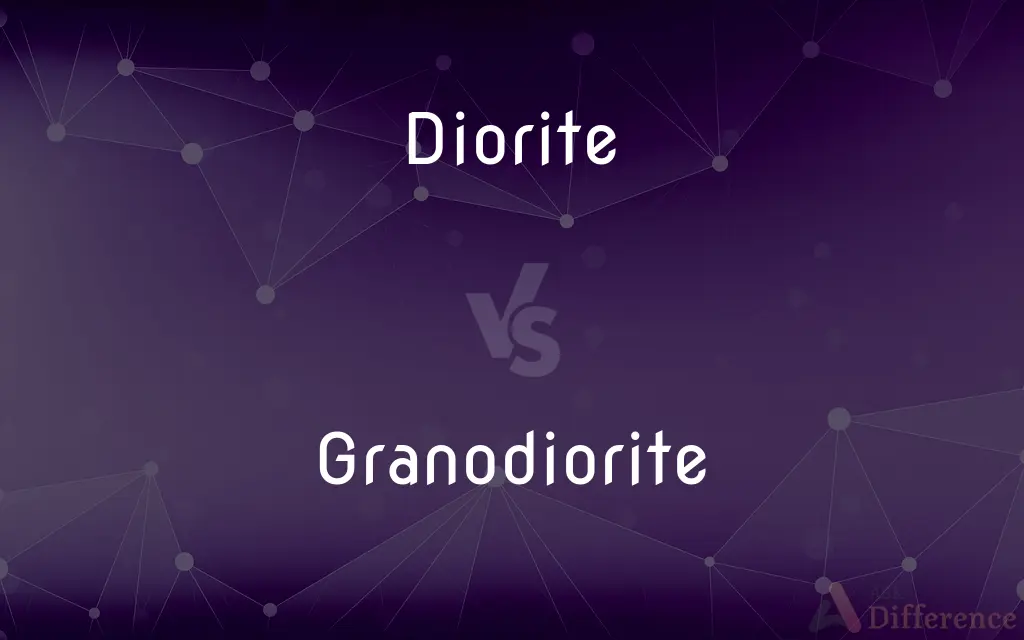Diorite vs. Granodiorite — What's the Difference?
By Tayyaba Rehman & Fiza Rafique — Updated on April 4, 2024
Diorite is denser and darker, primarily composed of plagioclase, hornblende, and minor mafic minerals, while granodiorite, lighter in color, has more quartz and less dark minerals.

Difference Between Diorite and Granodiorite
Table of Contents
ADVERTISEMENT
Key Differences
Diorite is an intermediate intrusive igneous rock that is coarser in texture and darker in color, primarily due to its higher content of mafic minerals such as hornblende and biotite. Whereas, granodiorite is a lighter-colored rock, with a higher quartz content and less mafic minerals, reflecting a composition closer to granite but with more plagioclase than potassium feldspar.
Diorite forms deep within the Earth's crust from the slow cooling of magma that allows large crystals to grow, giving it a coarse-grained texture. On the other hand, granodiorite also forms in similar environments but tends to have slightly more silica content, which contributes to its lighter color and slightly different mineral composition.
The mineral composition of diorite includes a larger amount of plagioclase feldspar and hornblende, with occasional presence of pyroxene and biotite. Granodiorite, while also rich in plagioclase feldspar, contains a significant amount of quartz and less of the dark mafic minerals, giving it a lighter appearance.
Diorite is known for its durability and is often used in the construction industry for building and decorative stones. Granodiorite, with its lighter color and aesthetic appeal, is also used in similar applications, though its slightly different mineral composition can affect its performance in certain environments.
In terms of geographic distribution, diorite can be found in various parts of the world, including the Andes Mountains and parts of the UK. Granodiorite, however, is notably found in the Sierra Nevada mountains, among other locations, highlighting the diverse geological processes that lead to the formation of these rocks.
ADVERTISEMENT
Comparison Chart
Color
Darker, typically grey or bluish-grey
Lighter, often white to light grey
Texture
Coarse-grained
Coarse-grained, slightly finer than diorite
Main Minerals
Plagioclase, hornblende, biotite
Plagioclase, quartz, biotite, less hornblende
Silica Content
Lower (about 45-52%)
Higher (about 55-65%)
Uses
Building stone, decorative applications
Building stone, countertops, decorative elements
Compare with Definitions
Diorite
A coarse-grained, intrusive igneous rock composed mainly of plagioclase feldspar and hornblende.
The city's ancient structures were mostly constructed from diorite.
Granodiorite
Results from the crystallization of magma with a composition between granite and diorite.
Granodiorite formations indicate a complex geological history.
Diorite
Typically dark, ranging from grey to bluish.
The diorite's dark color provides a striking contrast in the garden.
Granodiorite
An intrusive igneous rock similar to granite but with more plagioclase feldspar than potassium feldspar.
The new city hall features granodiorite in its facade.
Diorite
Known for its coarse texture with visible grains.
The texture of diorite makes it popular for certain architectural details.
Granodiorite
Coarse-grained, though slightly finer than diorite.
The granodiorite's texture is ideal for detailed sculptural work.
Diorite
Forms from the slow cooling of magma beneath the Earth's surface.
Geologists study diorite to understand the Earth's internal processes.
Granodiorite
Used for countertops, buildings, and decorative purposes.
Granodiorite countertops are popular for their durability and beauty.
Diorite
Valued in construction and as decorative stone.
Diorite is often used in buildings for its durability and aesthetic appeal.
Granodiorite
Generally lighter, usually white to light grey.
The light color of granodiorite brightens up the interior space.
Diorite
Diorite ( DY-ə-ryte) is an intrusive igneous rock formed by the slow cooling underground of magma (molten rock) that has a moderate content of silica and a relatively low content of alkali metals. It is intermediate in composition between low-silica (mafic) gabbro and high-silica (felsic) granite.
Granodiorite
Granodiorite () is a coarse-grained (phaneritic) intrusive igneous rock similar to granite, but containing more plagioclase feldspar than orthoclase feldspar. The term banatite is sometimes used informally for various rocks ranging from granite to diorite, including granodiorite.
Diorite
Any of various dark, granite-textured, crystalline rocks rich in plagioclase feldspar and having little quartz.
Granodiorite
A coarse-grained igneous rock consisting primarily of quartz, plagioclase feldspar, and potassium feldspar, and also containing biotite, hornblende, or pyroxene.
Diorite
(rock) A grey intrusive igneous rock composed mostly of plagioclase feldspar, biotite, hornblende and/or pyroxene.
Granodiorite
(rock) An intrusive igneous rock similar to granite, but containing more plagioclase than potassium feldspar.
Diorite
An igneous, crystalline in structure, consisting essentially of a triclinic feldspar and hornblende. It includes part of what was called greenstone.
Diorite
A granular crystalline intrusive rock
Common Curiosities
What is diorite?
Diorite is a dark, coarse-grained igneous rock composed mainly of plagioclase feldspar and hornblende.
Where can diorite be found?
Diorite can be found in various places worldwide, including mountain ranges and ancient volcanic regions.
Where is granodiorite most commonly found?
Granodiorite is commonly found in mountainous regions, such as the Sierra Nevada.
What are the primary uses of diorite?
Diorite is used in construction, for decorative stones, and in some cases, for art sculptures.
Can diorite be polished?
Yes, diorite can be polished to achieve a smooth and shiny surface, ideal for decorative purposes.
What is granodiorite?
Granodiorite is an intrusive igneous rock with a composition that includes more plagioclase feldspar and quartz than diorite.
What is the color range of diorite?
Diorite typically ranges from grey to bluish-grey, indicating its mineral composition.
How does the texture of granodiorite compare to diorite?
Granodiorite's texture is coarse-grained like diorite but slightly finer due to its mineralogy.
What distinguishes granodiorite from granite?
Granodiorite has more plagioclase feldspar relative to potassium feldspar, while granite has more quartz.
Is granodiorite suitable for countertops?
Yes, its durability and aesthetic appeal make granodiorite a popular choice for countertops.
How do diorite and granodiorite form?
Both form from the slow cooling of magma beneath the Earth's surface, allowing large crystals to grow.
Why is diorite considered durable?
Its dense composition of hard minerals makes diorite resistant to weathering and abrasion.
What factors influence the color of granodiorite?
The color is influenced by its quartz and feldspar content, leading to its lighter appearance.
Are diorite and granodiorite used in outdoor applications?
Yes, both rocks are used in outdoor applications due to their durability and resistance to weathering.
How do geologists differentiate between diorite and granodiorite?
Geologists use the rock's mineral content and texture to differentiate between the two.
Share Your Discovery

Previous Comparison
Cuckoo vs. Koel
Next Comparison
Vigilant vs. WaryAuthor Spotlight
Written by
Tayyaba RehmanTayyaba Rehman is a distinguished writer, currently serving as a primary contributor to askdifference.com. As a researcher in semantics and etymology, Tayyaba's passion for the complexity of languages and their distinctions has found a perfect home on the platform. Tayyaba delves into the intricacies of language, distinguishing between commonly confused words and phrases, thereby providing clarity for readers worldwide.
Co-written by
Fiza RafiqueFiza Rafique is a skilled content writer at AskDifference.com, where she meticulously refines and enhances written pieces. Drawing from her vast editorial expertise, Fiza ensures clarity, accuracy, and precision in every article. Passionate about language, she continually seeks to elevate the quality of content for readers worldwide.













































